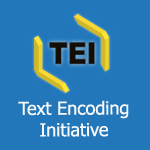There are three main parts of the TEI header in this file. First, the file description provides general bibliographical information. In this case, the file description is split into two sections labelled “title statement” and “publication statement.” Together, the information here includes the name of the piece, the author, and the “distributor” [of the poem]. Importantly, the publication section includes contact information for the distributor, Professor Leuner. Second, the source description is functionally a deeper bibliography of the source itself, the Williams’ poem. It contains information about the publisher, the date of publication, and the relevant digital tools (for example: Google Books digital edition). Third, the encoding description typically provides information about the relationship between the digital text and its original source. The digitized Williams’ poem was produced by transcribing the Google Books scan. Basically, the TEI header conveys information relating to bibliography and digitalization.
The relationship between the header and the body is straightforward and mutually reinforcing. The header provides necessary contextual information for the body. For example, the date of publication helps provide a particular frame of reference for the reader of the body. The body gives the header substance. Without the body, the piece would functionally just be a title and publication information. To analogize, a header without a body is like a book’s bindings without the book, and a body without a header is like a book without a cover [or cover pages].
Thus, the header is of critical importance to the reader of the file because it provides key context. I think it is necessary for the header to be so lengthy because it functions almost like an encyclopedia for contextual information. Without a thorough header, the reader would potentially not be able to locate important information about the source and its digital publication.
I am still confused about TEI in general. How does one access a TEI version of a source? What purpose does a coded file on a source serve? Most importantly, what is the relationship between TEI and the digital humanities?

One response to “Purpose of TEI Headers”
Pirzada, I think you did a great job understanding the relationship between the header and the body of a TEI file. Your analogy to a book without a cover, or the binding with no book, is brilliant, and I’m going to borrow that (and cite you) when I teach this next!
Your questions are right on the money. Often, in DH projects the TEI version of a source will be accessible by a link on the page itself, open access. This is “best practice.” Here is an example from the Shelley-Godwin Archive: it’s the transcription and encoding of Mary Shelley’s draft of Frankenstein. http://shelleygodwinarchive.org/sc/oxford/frankenstein/volume/i/#/p1. If you look on the menu bar, just to the left of “search” there is a button you can click on to view the TEI encoding. Can you find that?
The purpose of the coded file depends on the project. You’ve hit on *the* money question for encoding, and it’s so important to be selective about how and what to encode. The TEI encoding will mark up the elements of a document that are structurally and thematically important to preserve for analysis or for archival purposes. I think my lecture on markup I assigned for reading for Thursday does a pretty good job of showing this with examples. Maybe revisit the example from Wordsworth’s Guide to the Lakes as well as the encoding of the sonnet. We can talk more about this together!